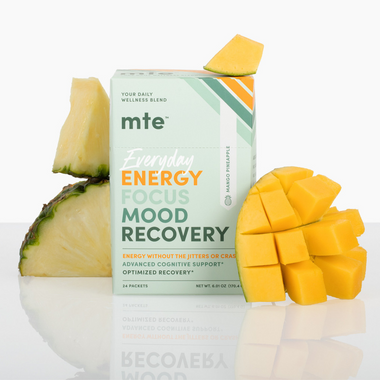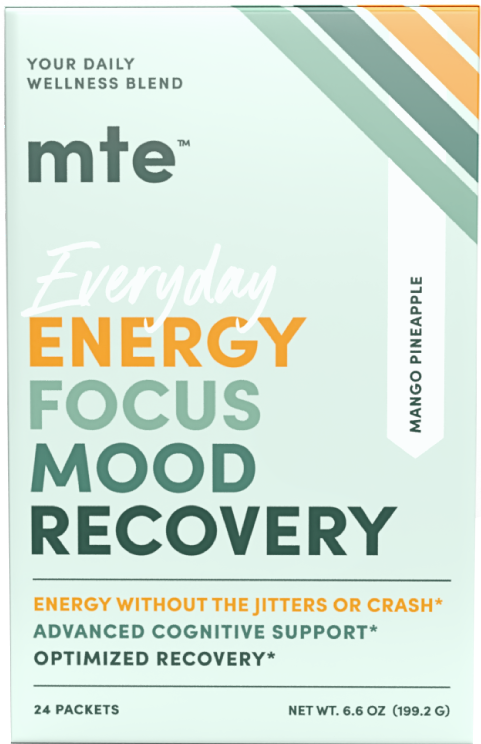
Paraxanthine: So There’s a Part of Caffeine That’s Actually Healthy?
Paraxanthine is a natural byproduct of caffeine and the new it-girl in the world of wellness and performance supplements. Touted for its ability to promote jitter-free energy and focus without the tolerance or rebound associated with caffeine, the claims are big for such an unknown compound. And despite its suspicious-sounding name (it ends in “ine”, after all), it’s proving a safe, healthy alternative to problematic energy boosters like caffeine, taurine, carnitine, ephedrine – you get it.
But wait – isn’t it still technically caffeine, though? That’s a question for the lone scholar in all of existence that works at the intersection of biology, pharmacology and philosophy. And we don’t know that person, so we couldn’t ask. What we can say is that paraxanthine is a metabolite of caffeine, and that studies indicate it’s distinct from caffeine, both chemically and in its effects.
Well, a couple decades ago someone figured out how to isolate paraxanthine, and just recently someone figured out how to synthesize paraxanthine to produce it for use in wellness drink powders, caffeine-free energy drinks, pre-workouts, and more. Now, let’s discuss the ins and outs of this important component of caffeine – its biological actions and effects, how paraxanthine compares to coffee, what the research says, and whether paraxanthine really is the caffeine-free holy grail of energy everyone’s been looking for. Not to be dramatic about it or anything…
What is Paraxanthine?
Caffeine is almost totally metabolized in the liver, which breaks it down into 3 main byproducts, referred to as metabolites. Paraxanthine is caffeine’s primary metabolite, making up 84% of the breakdown products. More importantly, this metabolite seems to be responsible for the positive effects of caffeine by acting on similar signal pathways without evoking the stress response caffeine does, resulting in jitter-free energy.
Paraxanthine plays a key role in caffeine’s ability to increase fat burn (thermogenesis), as well as focus and concentration. It also has a longer half-life than caffeine, meaning it is metabolized slower and more gently for a sustained energy boost without the roller coaster of highs and lows.
This nootropic doesn’t occur naturally in plants but is observed only as a caffeine metabolite in humans and animals. That's why it had to be synthesized in order to become an isolated ingredient that could be added to things like healthy drinks for energy and focus. So, it’s not artificial, but it is synthetic… another semantic dilemma for that lone biologist-pharmacologist-philosopher somewhere out there. It’s too meta for us; we make wellness drink powders.
How Does Paraxanthine Work?
We don’t yet have many specifics on exactly how paraxanthine accomplishes its effects, but we do know it interacts with and/or modulates several neurotransmitters key in promoting energy, focus and mood while dampening stress and inflammation. For instance, paraxanthine:
- antagonizes adenosine (A1, A2A) receptors, which dampens fatigue signaling, resulting in a more alert mind and body.
- increases extracellular levels of dopamine, which improves energy, mood and focus while reducing stress.
- induces cGMP accumulation. cGMP promotes healthy cell signaling, including vascular dilation, eye function, calcium levels, and neurotransmitter activity. cGMP also calms the hippocampus down by promoting glutamate, which has been shown to improve cognition.
- inhibits poly (ADP-ribose) polymerase-1 (PARP-1) activity, which results in anti-inflammatory effects.
What Are the Differences Between Caffeine & Paraxanthine?
Virtually all research indicates that paraxanthine is safer than caffeine, has less toxic effects, and causes less anxiogenic (read: to do with stress/anxiety) symptoms than caffeine. Research has also shown that it’s not the metabolite responsible for the diuretic effect of caffeine, so another pro: you don’t have to pee all the time after a paraxanthine drink vs a caffeinated one.
Let’s look at what the science has to say about paraxanthine side effects vs caffeine’s – or, rather, caffeine’s side effects and how paraxanthine doesn’t cause them.
Tolerance/Dependence
A 2023 review of the literature on the toxicology of paraxanthine vs caffeine found that studies support paraxanthine has low abuse liability (read: chance of dependence/addiction) and also doesn’t mediate the addictive aspects of caffeine.
A 2016 study on male rats literally tried to get rats addicted to paraxanthine to see if it had the same addictive effects as known addictive stimulants. All they ended up with was a bunch of rats with a cocaine addiction; paraxanthine didn’t elicit any addictive behaviors.
Jitters/Anxiety
A patent application for use of paraxanthine for treating a neuropsychiatric condition cited several studies indicating anxiolytic (read: anti-anxiety/stress-reducing) effects of paraxanthine at the same doses caffeine causes anxiogenic (read: anxiety-causing) effects.
Two interesting things here: (1) Caffeine caused anxiogenic effects at a dose of just 50mg, and (2) it only took 25mg of paraxanthine to cause an anxiolytic effect.
Crash/Sleep Disturbance
A 2010 study on paraxanthine and narcolepsy had equal wakefulness effects to caffeine but no sleep rebound/crash after.
A 2020 review article reiterated that the crash after caffeine is caused by withdrawal, and that paraxanthine does not cause this withdrawal that brings on headaches, fatigue, irritability, and low mood.
Does Paraxanthine Work Apart from Caffeine?
How is paraxanthine able to offer energizing properties, then? Does it work apart from or in tandem with caffeine? Can you really have your cake and eat it too? I.e. Can you consume a healthy energy drink that actually works without making you feel like ending it all? The science sure looks like it.
In 2024, a randomized, double-blind crossover study looked at paraxanthine vs caffeine compared to placebo by testing several combinations and isolations of both compounds. Twelve trained runners were given a cognitive test. They then either consumed 400mg placebo, 200mg each caffeine and placebo, 200mg each paraxanthine and placebo, or 200mg each of paraxanthine and caffeine. After a 60-minute rest, they took the test again. They then completed a 10km run and repeated the cognitive test for a third time.
The results were compelling:
- Correct responses in the paraxanthine group increased dramatically from pre-exercise to post-exercise.
- Error rates post-exercise were lower in paraxanthine than in both placebo and caffeine.
- Post-exercise reaction time was faster within the paraxanthine and caffeine groups.
- There was no evidence paraxanthine caused side effects, both reported and in blood markers associated with stimulant-caused stress response.
These results indicate two important factors that make paraxanthine such a promising ingredient in wellness boosters. First, that its effects are in fact distinct from caffeine, meaning you really can get all the benefits of caffeine without the downsides. Second, paraxanthine promotes frontal cortex function, which means better mood, focus, concentration, and alertness.
Does Research Support Paraxanthine as a Caffeine Replacement?
Paraxanthine’s mechanisms and actions are distinct from caffeine’s, which means you don’t sacrifice the efficacy of the stimulant even though you’ve eliminated the stress and low-mood effects. Research supports paraxanthine as a natural energy booster that performs the same as (or may even outperform) caffeine in energy, mood and focus benefits. Just a few relevant studies and reviews include:
For Energy
- 1990: A high positive correlation between the presence of paraxanthine and FFA markers in the blood was observed. FFA (free fatty acids) in the bloodstream are an indication of a mobilized metabolism.
- 1995: Paraxanthine was observed to produce the same energy-boosting blood markers as caffeine to an equivalent extent.
- 2022: Paraxanthine was observed to increase strength and physical performance while lowering LDL cholesterol (the bad one) and raising HDL cholesterol (the good one).
For Mood
Lab results and a subsequent analysis from 2013 confirmed that paraxanthine indirectly causes the release of dopamine. Later studies have also seen paraxanthine closely associated with increased extracellular dopamine as well. Interacting with dopaminergic activity (mood, motivation), as well as tangentially with glutamate (energy booster) and GABAergic activity (alert relaxation), contributes to the stress-reducing effects of paraxanthine.
For Cognition
It can be inferred that paraxanthine supports cognition, as increased extracellular dopamine should contribute to improved ability to learn and remember – dopamine plays a huge role in absorbing and maintaining information. A 2008 study supported this inference when paraxanthine was observed to have a neuroprotective effect against dopaminergic cell death.
- 2021: A single dose of paraxanthine contributed to increased cognition, memory, ability to learn, and ability to sustain attention.
- 2024: The study on runners we discussed earlier demonstrated that paraxanthine boosts cognitive performance on tasks even despite physical exhaustion. In fact, while paraxanthine reduced errors in testing after physical exertion, caffeine increased errors.
Paraxanthine drinks and healthy energy powders using this nootropic are just starting to emerge. MTE takes advantage of new production technologies by Enfinity® to offer our caffeine-free wellness powder, the Everyday Blend. Powered by paraxanthine instead of caffeine, you can expect the support for jitter-free energy, mood and focus you’re looking for without being followed by the stress, irritability and exhaustion you’re used to.
Curious to feel the effects? Order your dose of MTE's paraxanthine energy drink.






